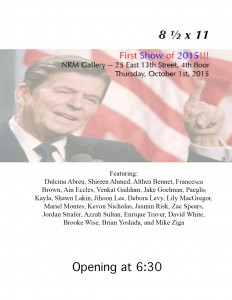NRM is pleased to announce the inaugural show of the season, 8 ½ x 11.
Featuring work by: Dulcina Abreu, Shireen Ahmed, Althea Bennett, Francesca Brown, Ain Eccles, Venkat Gaddam, Jake Goelman, Paeglis Kayla, Shawn Lakin, Jihoon Lee, Debora Levy, Lily MacGregor, Mariel Montes, Kevon Nicholas, Jasmin Risk, Zac Spears, Jordan Strafer, Azzah Sultan, Enrique Traver, David White, Brooke Wise, Brian Yoshida, Mike Ziga, and anonymous.
On August 30th, 1921 President Herbert Hoover organized the Committee on the Simplification of Paper Sizes in hopes to save money and somehow create less waste. He decided that 8 x 10 ½” would be the new “Government Size”. It wasn’t until Ronald Reagan was president and the use of copy machines became wide spread that there was need for a new size. 8 ½ x 11” had always been used as a commercial paper size, but during the 1980s it was adopted by the government as the official paper size for the Federal Government.
Other than this little known history, the seemingly neutral and universal paper size manifests in many utilitarian forms and can commonly be found in copy machines and printers around the world. Schools, businesses, corporations, anything involving a contract or waiver will usually employ the ubiquitous paper size. The art world is no stranger to the paper size. Press releases, contracts, grant applications, and other business matters “behind the scenes” are all manifested in the standard paper size. Upon the start of an upcoming school year, 8 ½ x 11” papers can be found posted up around campuses and on the streets, perhaps offering tutoring or notifying the public of a lost animal. 8 ½ x 11” is a scale commonly implied to have been reproduced or is reproducible. For this group show, NRM invited artists to respond to these circumstances within the very same size constraint. Is the question of reproducibility and the aura implicated when using the standard paper size? When can the well-known contexts of 8 ½ x 11” be identified with, and when can they be negated? What do all of the usual contexts of the standardized paper size have in common? When is hanging sheet of paper utilitarian and at when has it become an intentional art object? What meanings do a collection of work embody when forced into the standardized size constraint? What are the broader implications of standardization? By blending in with the institutional landscape, 8 ½ x 11 presents the participating artists’ points of view while also bearing in mind all of these questions.
